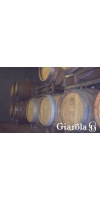Wine from Giarola

The Giarola Estate
Giarola is located in Palazzolo di Sona, in the province of Verona, near the Garda Lake, in those regions which are geographically ideally suited for the production of Bardolino and Custoza wine.
These morainic terrains have a particular historic importance and they originate in the Quaternary glacial period when ice retired itself, leaving behind finely triturated rocks and rubble, transforming them in fine clay, ideal for vintage wines.
The mild and temperate climate and the strategic position in the inland around Garda lake, where lace-like sunshine and gentle breezes create the right climate for a luxuriant vegetation, are the elements which brought about the d.o.c. and d.o.c.g. denominations for all production areas of the company.
Since 1923 the land of Giarola family has been cultivated with vines and in 1968 Umberto Giarola began with the vinification of grapes. In last years, we have many developments and decidedly radical changes.
They are all founded in the philosophy which inspires the company and we can sum up in the following concept: "Respect for the Environment and Love for Nature".
Firmly adhering to this principles, the company has always been able to be in the vanguard and move with the times. Important examples are the total renewal of the vineyards and the implementation of the double curtain breeding system with a density of 6.000 plants per hectare; the controlled ground-irrigation system in case of drought in order to avoid stress to the vines maintaining the quality of the fruit. The company has invested heavily in land, machinery and staff not only in order to grow in numbers, but also to refine the techniques for grape-growing and winemaking.
Main “people” of the company are Umberto, the father and his sons Michele and Valeriano. Umberto supervises the various production processes and coordinates, in particular he works in the vineyards and the winemaking process itself.
The job of Valeriano, with his father, concerned in oenological processes and the fields. As far as Valeriano concerned, he also works for the packaging sector. During the first phase particular importance is given to the repeated soil- and leaf-analysis in order to ascertain the presence of all nutritional elements necessary for the balanced development of the plant.
Very important is the cold maceration for Custoza Elite and Garganega Monte Cristo tardy vintage. Michele has an important role: the commercial development of the company. In fact he goes in the best restaurants and wine shops throughout Italy also crossing the borders of Germany, Switzerland and Canada, to attract attention of our products. This gives rise to hope and sustains an ambitious project: to raise the image of Giarola wines to the highest level worldwide, maintaining direct contact with the company, in order to guarantee personally the quality of the product. The union of tradition and innovation offers consumers an ample choice of wines, able to satisfy the palate of those in search of high quality.
The Giarola Vineyard
The estate spreads over 12 hectares (30 acres) of vineyard planted to sandy, gravelly soil ideal for grape growing.
No products found
- back
Selected Options
Wineries
Categories
Pricing
Countries
Regions
Grape Types
Wineries
Organic/Free Shipping
• 100% pure Sauvignon Blanc, crafted from grapes grown in the most notable and warmer regions of California’s coastal hills. Each block contributes a distinct element to the blend, resulting in a layered and complex style.
• The harvest dates were determined by physiological maturity, which varied widely in the 2023 vintage due to the wet winter leading to a cool summer. Nevertheless, the extended hang time reduced grapes with low sugar, firm acid, minimal pyrazines, and intense flavor expressions.
• Upon arrival at the winery, the whole clusters underwent a gentle pressing, and the juice underwent a cold settling process for two days. Subsequently, it was racked off the heavy lees into stainless steel tanks, where it underwent a chill fermentation with native yeast – which contributed to the balanced mouthfeel, set against a backdrop of minerality and acidity.
• Following fermentation, the wines remained in tank, with the lees being stirred weekly for nearly four months before the final blend was assembled. No malolactic fermentation was allowed, preserving the vibrant fruit and floral notes, alongside the natural tension characteristics of this blend.
Color:
Medium yellow straw hue.
Aroma:
Asian pear, honeysuckle, passionfruit,
green melon, and a citrus bouquet.
Palate:
Refreshing stone fruit, grapefruit, and tropical flower. This wine has a well-balanced mouthfeel with bright and lively acidity.
Food Pairing:
Oysters on the half shell with mignonette sauce,
niçoise salad, a blue cheese pear tart and crab cakes.
Cap Cette Picpoul de Pinet is made from 100 percent Picpoul de Pinet
A very popular, traditional local variety planted on sun-drenched hillsides called "costières" (coastal region) in the Mediterranean garrigue, near the Etang de Thau - a coastal lagoon situated between the port of Sète and Marseillan.
The color is a superb pale yellow with bright hues. The nose is elegant, with aromas of fresh fruit and citrus fruit especially grapefruit. Well-balanced with typical focusing and zesty acidity. A pure expression of the grape varietal, the wine shows how good Picpoul can be when grown on its favorite terroir.
It will complement a vast array of dishes such as Asian cuisine, sushi, spicy fare and all sorts of seafood and grilled fish. Enjoy!




